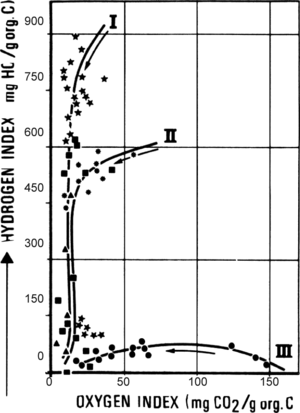Difference between revisions of "Rock Eval analysis using hydrogen index (HI) and oxygen index (OI)"
Cwhitehurst (talk | contribs) |
Cwhitehurst (talk | contribs) m (added Category:Treatise Handbook 3 using HotCat) |
||
| (6 intermediate revisions by 2 users not shown) | |||
| Line 6: | Line 6: | ||
| part = Critical elements of the petroleum system | | part = Critical elements of the petroleum system | ||
| chapter = Evaluating source rocks | | chapter = Evaluating source rocks | ||
| − | | frompg = 6- | + | | frompg = 6-18 |
| − | | topg = 6- | + | | topg = 6-18 |
| author = Carol A. Law | | author = Carol A. Law | ||
| link = http://archives.datapages.com/data/specpubs/beaumont/ch06/ch06.htm | | link = http://archives.datapages.com/data/specpubs/beaumont/ch06/ch06.htm | ||
| Line 14: | Line 14: | ||
| isbn = 0-89181-602-X | | isbn = 0-89181-602-X | ||
}} | }} | ||
| − | Obviously, the two main elements of hydrocarbons are hydrogen and carbon. Therefore, once we know the amount of [[total organic carbon (TOC)]] present in a rock, we then need to know the amount of hydrogen present in order to assess overall source rock quality. The amount of oxygen and hydrogen present in the kerogen defines the [[ | + | Obviously, the two main elements of hydrocarbons are hydrogen and carbon. Therefore, once we know the amount of [[total organic carbon (TOC)]] present in a rock, we then need to know the amount of hydrogen present in order to assess overall source rock quality. The amount of oxygen and hydrogen present in the [[kerogen]] defines the kerogen as type [[Type I kerogen|I]], [[Type II kerogen|II]], or [[Type III kerogen|III]] and if the rock will be oil or gas prone. |
==Hydrogen index== | ==Hydrogen index== | ||
| − | The hydrogen index (HI) represents the amount of hydrogen relative to the amount of organic carbon present in a sample. The [[Rock-Eval_pyrolysis#Rock-eval_pyrolysis|S2 curve]] of a Rock-Eval analysis can help us determine the total amount of hydrogen in milligrams of hydrogen to grams of sample according to the following formula: | + | The [[hydrogen index]] (HI) represents the amount of hydrogen relative to the amount of organic carbon present in a sample. The [[Rock-Eval_pyrolysis#Rock-eval_pyrolysis|S2 curve]] of a Rock-Eval analysis can help us determine the total amount of hydrogen in milligrams of hydrogen to grams of sample according to the following formula: |
:<math>\mbox{HI} = \mbox{S2} \mbox{ (Mg/g)}/\%\mbox{TOC} \times 100</math> | :<math>\mbox{HI} = \mbox{S2} \mbox{ (Mg/g)}/\%\mbox{TOC} \times 100</math> | ||
| Line 38: | Line 38: | ||
* [[Kerogen type and quality: visual assessment]] | * [[Kerogen type and quality: visual assessment]] | ||
* [[Pyrolysis gas chromatography]] | * [[Pyrolysis gas chromatography]] | ||
| + | |||
| + | ==References== | ||
| + | {{reflist}} | ||
==External links== | ==External links== | ||
| Line 47: | Line 50: | ||
[[Category:Critical elements of the petroleum system]] | [[Category:Critical elements of the petroleum system]] | ||
[[Category:Evaluating source rocks]] | [[Category:Evaluating source rocks]] | ||
| + | [[Category:Treatise Handbook 3]] | ||
Latest revision as of 18:09, 9 February 2022
| Exploring for Oil and Gas Traps | |

| |
| Series | Treatise in Petroleum Geology |
|---|---|
| Part | Critical elements of the petroleum system |
| Chapter | Evaluating source rocks |
| Author | Carol A. Law |
| Link | Web page |
| Store | AAPG Store |
Obviously, the two main elements of hydrocarbons are hydrogen and carbon. Therefore, once we know the amount of total organic carbon (TOC) present in a rock, we then need to know the amount of hydrogen present in order to assess overall source rock quality. The amount of oxygen and hydrogen present in the kerogen defines the kerogen as type I, II, or III and if the rock will be oil or gas prone.
Hydrogen index
The hydrogen index (HI) represents the amount of hydrogen relative to the amount of organic carbon present in a sample. The S2 curve of a Rock-Eval analysis can help us determine the total amount of hydrogen in milligrams of hydrogen to grams of sample according to the following formula:
Oxygen index
The oxygen index (OI) represents the amount of oxygen relative to the amount of organic carbon present in a sample. The S3 curve of a Rock-Eval analysis can help us determine the total amount of oxygen present in a sample according to the following formula:

Determining kerogen quality
The type of kerogen present in a rock determines its quality. Type I kerogen is the highest quality; type III is the lowest. Type I has the highest hydrogen content; type III, the lowest. To determine the kerogen type present in a source rock, plot the hydrogen and oxygen indices on a modified Van Krevlen diagram (Figure 1).
Caveat
Use the HI/OI technique only to determine source rock quality (kerogen type) of immature rocks. HI and OI change as a source rock matures (the amount of hydrogen and oxygen relative to carbon decreases and the HI/OI ratios converge toward the origin of the plot, leading one to a more gas-prone type III interpretation). Therefore, in mature rocks HI and OI are not indicative of the original kerogen quality.
See also
References
- ↑ Tissot, B. P., and D. H. Welte, 1984, Petroleum Formation and Occurrence, 2 ed.: New York, Springer-Verlag, 699 p.
External links
- Rock Eval 6 — Product page at Vinci Technologies
- Original content in Datapages
- Find the book in the AAPG Store

